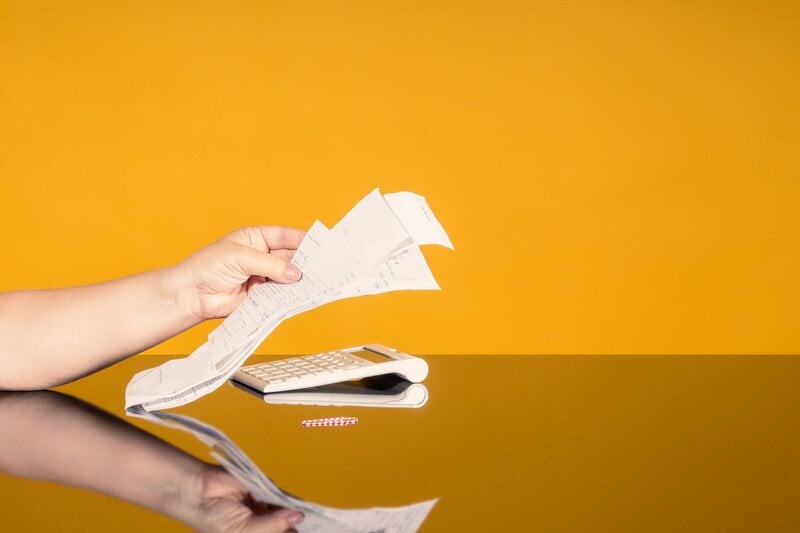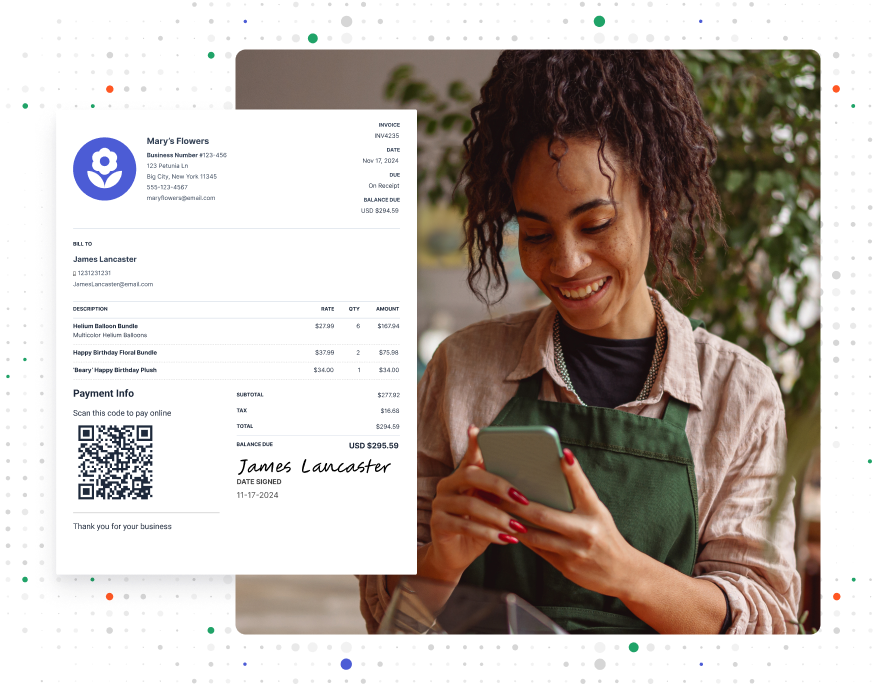How To Fill Out a Receipt Book: A Complete Guide

Different situations call for different payment methods. Sometimes, you write an invoice for freelance work. Maybe you send a bill. Other times, you’re in the field and customers want to pay you immediately. That’s where a receipt book comes in handy.
Receipt books make it easy to track payments you receive on the fly. But to make effective use of this tool, you need to know how to fill out a receipt book.
Here’s how to use a receipt book for easier recordkeeping and more customer trust.
What Is a Receipt Book?
A receipt book is a book of pre-printed receipts you can fill out to quickly provide customers with proof of payment. The form contains lines for basic information, like the items purchased and your company’s contact details. There’s also a place for an itemized list of the products you sold or the services you provided.
The receipts in the book usually have a detachable top page you can remove to give to customers. Every other page is a carbon copy, so a record of the information you write on the top page stays in your book. You end up with a book full of receipts in chronological order that shows which customers paid you and when.
Most receipt books have color-coded pages, so you can tell which is the original and which is the carbon copy. The top page you tear out and give to customers is usually white. The copy that stays in the book is yellow.
Having a receipt book is handy if you frequently collect payments on the go. You don’t always have the resources to print one out or the time to wait until you get back to your office. All it takes is the book and a pen.
How Do You Fill out a Receipt Book?

It’s easy to learn how to write a receipt because the book walks you through every step of the process. While it may seem complicated, all you have to do is write the correct information in the blank lines on the template. That’s all you need to know how to fill out a receipt book.
Here’s the information you usually need to include.
1. Write the Date and Receipt Number
Some receipt books come with pre-numbered receipts. But in others, you need to write in a receipt number. You can choose any number you want, but it’s best to have a system so you can easily track payments. For example, you might start with 1000, 1001, etc.
There should also be a place to put the date. Choose between the date you performed the service or the date the customer paid you. It doesn’t matter which of these options you pick, as long as you’re consistent so you know what your records show.
2. Include All Relevant Contact Details
Include all your business information on the receipt so customers can track who they paid for their own records. Writing company details also makes it easier for customers to find you for repeat service. They can just refer back to their receipt.
You should usually include the following details:
- Company name
- Address
- Phone number
- Website
3. List a Description of Products
Receipts record what a customer paid for. Each one usually contains a grid with many rows of lines so you can make an itemized list of the items to include.
When writing items down, be as detailed and specific as you can, especially if you sell multiple versions of the same product. This prevents potential miscommunications. For example, if the customer bought a black mug and a white mug, list each one on a different line. Always describe the size, color, or other distinguishing features.
4. Include the Price
In each row on the receipt, there’s a space for the price and quantity. Write down both in the correct area for each product.
If you sell multiple quantities of any one item, multiply the number by the quantity to get the total price for those items. For example, if you sold four $10 mugs, the total price on the “mug” line on the receipt would show that the customer paid $40.
5. Add the Subtotal Amount
Add up the amount the customer paid for all items, also known as the subtotal. List this on the receipt so customers know the total amount going directly to your business.
6. Account for Taxes and Additional Charges
Usually, there are additional charges beyond the cost of the products, like taxes and delivery fees. Add those extra charges up after adding up the subtotal, and be sure to include details on the receipt showing what they are.
7. Calculate the Grand Total
Add all prices and fees to get the grand total. Include this total in a very visible way on the receipt so your customers can see it at a glance.
RELATED ARTICLE — 10 Common Invoicing Mistakes and How To Avoid Them
Why Is It Important to Keep a Receipt Book?
If you prefer paper receipts, these books are key for on-the-go documentation. Here are some of the big advantages:
- Prevent Errors. Avoid invoicing mistakes by keeping track of what services you provided and what items customers paid for. If you have a copy of the receipt, you’re less likely to double-bill someone who already paid.
- Provide a Customer Receipt Quickly. The book makes it easy to write a document for a customer in seconds. You don’t have to worry about how to make a receipt of payment. You can just pull out your book every time.
- Keep Records. The book keeps all receipts in one convenient place, making for an easier accounting process. All you have to do is flip through the book.
- Manage Inventory. Clear documentation makes it easy to see what you’ve removed from your inventory and need to restock. The information is right there in the book.
- Resolve Disputes. Keeping detailed records of the services and amounts prevents miscommunications. When you and the customer have the exact same copy of the receipt, there are no surprises.
RELATED ARTICLE — How To Send an Invoice
4 Tips for Filling Out a Receipt Book

Like with an invoice book or other accounting records, accuracy is crucial. With the right process, you can ensure your book is as useful as possible for your business.
Here are some tips:
- Be Consistent. The numbering system and methodology for listing items must be as consistent as possible. This helps customers know what to expect. It also speeds up your accounting and inventory management processes. You can look at any receipt and see at a glance what you sold and how much you made.
- Opt for Ink. Use a blue or black pen instead of a pencil. This helps ensure the carbon copy that stays with your book is easy to read and legible.
- Maintain a Backup. You don’t want to lose your book and the entire record of all your business transactions. Put the right backup process in place to prevent this. This may include maintaining multiple paper copies or making digital copies.
- Automate as You Grow. Manually writing receipts is easy when your business is small. But it could become too time-consuming and difficult to track as you grow. Look into invoicing software and tools to automate the process. Many programs can generate receipts for you and store copies digitally to make searching them fast and simple.
RELATED ARTICLE — Small Business Tax Returns: Everything Business Owners Need To Know
Simplify Your Business Accounting With Invoice Simple
Whether you’re preparing invoices or writing receipts, efficiency is key. That’s why Invoice Simple’s software is here to help.
Invoice Simple’s business expense and receipt tracker lets you scan any receipt and capture key info automatically into your digital system. All data is ready to export into a summary report whenever you need it.
Using the right tools to record both income and expenses lets your business focus on serving customers better. No more worrying about paperwork.
Start Your First
Invoice Today
Create customized and professional
invoices and connect with clients
